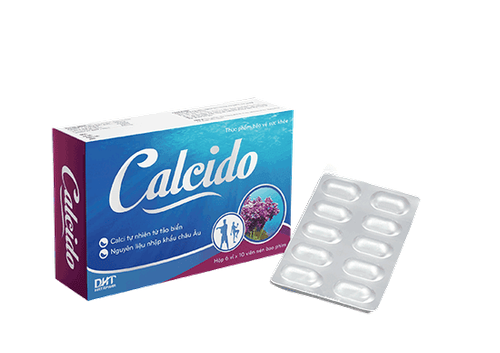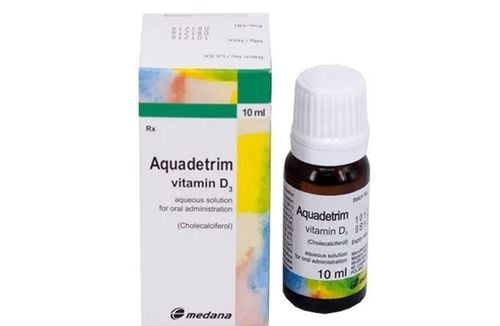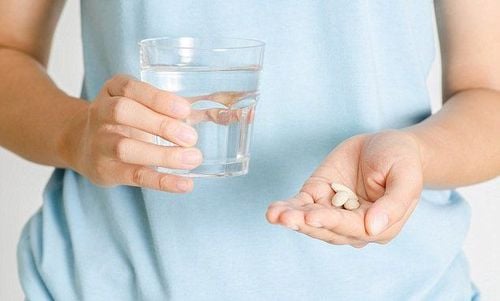This is an automatically translated article.
The article was professionally consulted by Doctor Vo Ha Bang Suong - General Internal Medicine - Department of Examination & Internal Medicine - Vinmec Phu Quoc International General HospitalVitamin D3 is often used to treat or prevent a condition caused by a vitamin D deficiency, especially a skin or bone condition. This vitamin is better than other vitamin D and increases blood levels of vitamin D higher than vitamin D2. Vitamin D3 will work when used in the right dose and time. Therefore, how to use vitamin D3 effectively but still ensure safety for the body is something that many people are interested in today.
1. What does Vitamin D3 do?
Vitamin D3, also known as cholecalciferol, is a fat-soluble vitamin that is processed through the liver and kidneys. When active in the body, this vitamin will bind with certain cells in the body to regulate calcium and phosphorus from food. Vitamin D3 offers many health benefits, such as:1.1 Bones Vitamin D can enhance the absorption of calcium in the small intestine, supporting bone density and muscle growth. If the body does not have enough vitamin D to absorb calcium, the body will remove calcium from the bones. This makes bones weak and fragile and increases the risk of osteoporosis.
Studies show that getting enough vitamin D can reduce the risk of fractures and improve muscle strength. In addition, getting high levels of vitamin D3 in the diet can help the body achieve peak bone mass in adulthood and prevent osteoporosis.
1.2. Immune system Many studies show that adequate vitamin D3 supplementation can protect the body from acute respiratory infections and pneumonia.
1.3. Cardiovascular Research shows that people with obesity and high blood pressure often have low levels of vitamin D3. Therefore, some conclusions suggest that adequate vitamin D3 supplementation can lower blood pressure and reduce the risk of stroke and heart attack.
1.4. Weight loss In some studies in postmenopausal women, supplemented with adequate amounts of vitamin D3 needed, often with low waist circumference and BMI at a healthy level.
Although vitamin D has many health benefits, the body cannot synthesize this vitamin on its own. Vitamin D3 is made by the body when the skin is exposed to sunlight. Sunscreen, protective clothing, limited exposure to sunlight, dark skin, and age can prevent the body from getting enough vitamin D from the sun. Another source of vitamin D3 of vitamin D3 is from food, the foods people eat every day. Therefore, you need to know how to properly and effectively supplement this vitamin source for your body. This is essential to ensure the normal functioning of the body. When natural sources are not enough, using vitamin D3 in pharmaceutical form and functional food is essential.
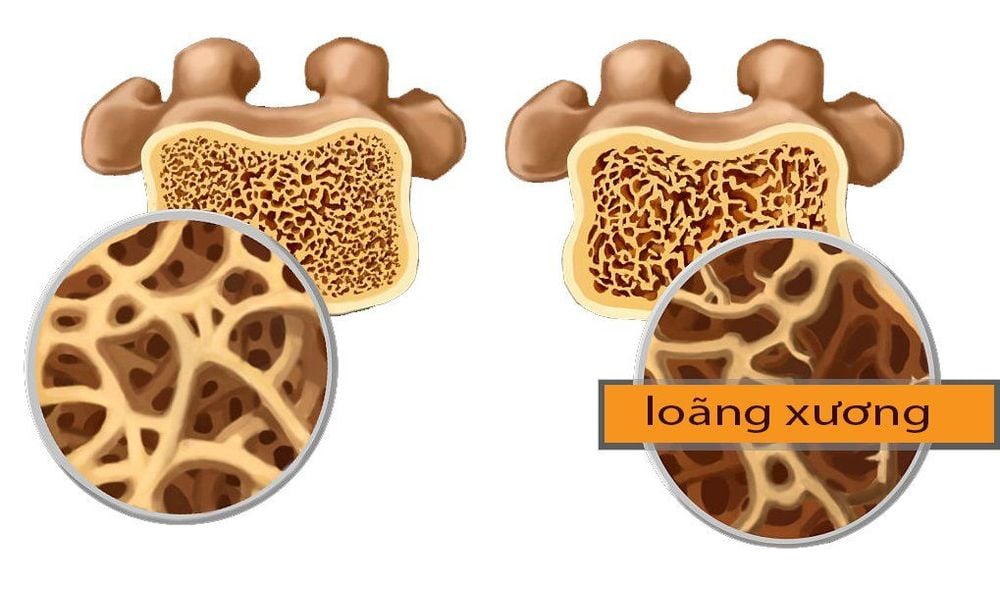
Vitamin D3 giúp ngừa loãng xương
2. How to supplement vitamin D3 for the body
If you need to supplement vitamin D for the body, you can use vitamin D tablets, exposure to the sun or increase the amount of foods containing vitamin D.2.1. Vitamin D3 Supplements Supplementing with vitamin D through food is one of the safest and simplest ways. Specifically, foods containing vitamin D3 include:
Animal sources: Beef liver; Butter; Cereals; Cheese; Cod liver oil; Yolk; Fresh salmon; Halibut; Mackerel; Milk fortified with vitamin D; Pilchard; Tuna. Plant sources: Almonds; Peas; Oat; Vitamin D fortified soy milk; Although there are many foods that contain vitamin D, it is often difficult for the body to absorb the entire amount of vitamin D through the diet.
2.2. Sun exposure When ultraviolet B (UVB) rays from sunlight hit special vitamin D receptor cells found in the skin, they trigger special chemical reactions and produce vitamin D3. . Therefore, exposure to the sun for 10-15 minutes a day can help you maintain the amount of vitamin D3 you need.
2.3. Supplementing vitamin D3 with oral products The target is children, it is necessary to pay attention to special vitamin D3 supplementation measures:
Vitamin D3 especially affects young children. Vitamin D3 deficiency does not have specific acute symptoms, but often there is a period of time when the symptoms are obvious before we can recognize it. Therefore, parents need to have knowledge about how to supplement vitamin D and abnormal signs in the child's development to seek the advice of a doctor.
Some notes when supplementing vitamin D3 in this age group, which are:
Sunbathing: This is a very effective and convenient method to help children supplement vitamin D. Parents can let their children sunbathe in the morning. in the morning, because this is the time when the baby's skin can be directly exposed to the sun without causing any harm to health. Sunlight at this time can promote the conversion of 7-Dehydrocholesterol to vitamin D3. Supplement vitamin D with food: Eat a variety of foods (all 4 food groups), use foods rich in vitamin D such as fish, eggs (egg yolks), liver, fish oil,... choose foods with vitamin D supplements such as milk, nutritional powder for children, flour, biscuits, margarine, cooking oil, cereals,... Eat calcium-rich foods such as shrimp, crab, fish, milk, and dairy products such as yogurt, flan, cheese,.... It should be noted that calcium in milk is easier to absorb than calcium from other food sources such as small fish with bones, shrimp and shrimp with shells, which contain a lot of calcium. . Meals need to have enough oil and fat to increase vitamin D absorption. It is recommended that children should be supplemented with 400 units of vitamin D every day. However, daily meals are difficult to provide enough needs. Children's vitamin D, especially those born prematurely, the body is born with insufficient vitamin D stores or children grow rapidly. Therefore, parents can choose functional foods with vitamin D3 to supplement their babies. About 15 days after birth until 3 years old, your baby can start to receive this essential vitamin supplement. It is best for parents to consult with a doctor before applying any vitamin D supplement method for children.
It should be noted:
In case the baby is using vitamin D-enhanced formula c, parents should base on the specified amount of calcium in the milk composition to supplement the missing part, to avoid overdoing it. The baby's body is affected by an excess of vitamin D.
2.4. How to take vitamin D3 to get the best effect For the vitamin to work optimally, you should use the right vitamin at the right dose and at the right time. Before taking, if you are allergic to vitamin D or other vitamin D products (such as calcitriol) or you have a medical history, especially of: high calcium/vitamin D levels, difficulty absorbing nutrients from foods , kidney disease, liver disease should consult a specialist.
If you use liquid Vitamin D3, carefully measure the dose with a dedicated measuring device/spoon. If you take Vitamin D3 chewable tablets or pills, chew the pill thoroughly before swallowing. If taking soluble Vitamin D3, dry your hands before taking the medicine. Place each dose on the tongue, wait for the medicine to dissolve, and then swallow with saliva or water. It is not necessary to mix Vitamin D3 dissolved form with water.
In addition, certain medications (such as cholestyramine/colestipol, mineral oil, orlistat) can decrease the absorption of vitamin D3. If you take these medications, take them at least 2 hours, as long as you can, before taking vitamin D3.
Since vitamin D3 is a fat-soluble vitamin, that means it needs fat for it to be fully absorbed by the body. Therefore, vitamin D3 is best taken with a meal that contains healthy fats such as avocados, eggs, nuts, coconut oil, olive oil, or chia seeds.
Time to use vitamin D3 during the day with meals or before bedtime. Take Vitamin D3 at the time you see fit. Usually, using it in the morning is more convenient and easier to remember. To avoid forgetting to take your dose, take your Vitamin D3 at the same time of day as a once-daily dose, or the same day/week as a once-weekly dose.
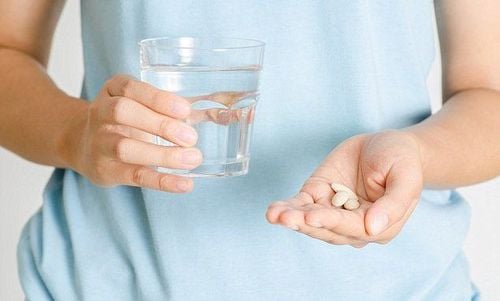
Sử dụng vitamin D3 theo chỉ định của bác sĩ
3. Side effects of Vitamin D3
Vitamin D3 in normal doses has almost no side effects. Therefore, if you have any unusual effects during use, contact your doctor or pharmacist as soon as possible.Too much vitamin D can cause an increase in blood calcium levels. Therefore, seek medical attention immediately if you have any signs of high vitamin D/calcium levels such as nausea/vomiting, constipation, loss of appetite, increased thirst, increased urination, changes in mind. unusual tiredness.
Allergic reactions are very rare when using vitamin D3. However, if you have any symptoms of a serious allergic reaction, including: rash, itching/swelling (especially of the face/tongue/throat), severe dizziness, trouble breathing, you should seek medical advice. medical facility for immediate emergency care.
4. Prevention of side effects when using vitamin D3 for children and adults
Before taking vitamin D3, tell your doctor or pharmacist if you are allergic to vitamin D3, other vitamin D products (such as calcitriol), or if you have any other type of allergy. Since vitamin D3 products may contain inactive ingredients such as peanuts/soybeans, ingredients that may cause allergic reactions or other problems, you should consult your doctor and pharmacist. Your pharmacist knows you have a peanut/soy allergy.Before using this medication, tell your doctor or pharmacist your medical history such as high calcium/vitamin D levels (hypercalcemia/vitamin D poisoning), difficulty absorbing nutrients from food ( malabsorption syndrome), kidney and liver disease.

Tham khảo dược sĩ về cách dùng thuốc an toàn
During pregnancy, the dose of vitamin D should only be used under the guidance of a doctor. Vitamin D3 can pass into breast milk, so it is necessary to consult to supplement vitamin D for mothers after giving birth properly, to avoid side effects.
Please dial HOTLINE for more information or register for an appointment HERE. Download MyVinmec app to make appointments faster and to manage your bookings easily.
Reference source: webmd.com




